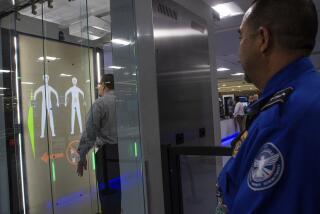Bioterror Tracking Test Set
- Share via
SAN FRANCISCO — Stanford University hospital is pioneering the testing of a new system to monitor the symptoms of patients brought to emergency rooms, in an effort to gain early warning of possible biological attacks.
The system--dubbed Biothreat Active Surveillance Integrated Information and Communication System, or BASIICS--was developed by Mountain View, Calif.-based Health Hero Network and could be in place in hospitals across Santa Clara County by the end of the month, officials said Thursday.
Among the signs tracked by the system are symptoms of anthrax, smallpox, hemorrhagic fever (Ebola) and plague--all of which have been highlighted as possible bio-weapons since the Sept. 11 terrorist attacks.
“Emergency department personnel are likely to be the first to encounter unusual patterns of illnesses that could result from bioterrorism, but many of the initial symptoms are nonspecific, such as fever and rash,” said Eric L. Weiss, an emergency physician at Stanford Hospital and Clinics.
The system places a simple, four-button device at admission stations, allowing hospital staff to immediately input data on symptoms exhibited by incoming patients.
That information is transmitted to an off-site data center where doctors, researchers or government agencies can analyze the broader, regional picture for early signs of unusually widespread incidence of specific symptoms.
“Public health officials want to know as soon as possible as soon as there is a problem, and in the case of bioterrorism activity that need is that much more acute,” Weiss said in an interview.
“A network of surveillance is so much more powerful than any one set of eyes,” he said. “We are not looking for a specific fever or rash; you are looking for increase over baseline” infection rates.
Public health experts say such systems would be an improvement over existing symptom-surveillance programs, which rely on paper tally sheets submitted to local health departments--a time-consuming exercise that frequently leads to underreporting.
The Stanford Hospital plan also has advantages over various Internet-based reporting systems that kick into operation only after doctors have identified potential problems and that require hospitals to configure their own computer systems to allow data input.
“With this system, you just plug it into into a phone jack and you are ready to go,” Weiss said.
The system is expected to be installed in most hospitals in Santa Clara County in coming weeks, providing the first real-time picture of emerging health threats, said Dr. Martin Fenstersheib, county health officer.
More to Read
Sign up for Essential California
The most important California stories and recommendations in your inbox every morning.
You may occasionally receive promotional content from the Los Angeles Times.












